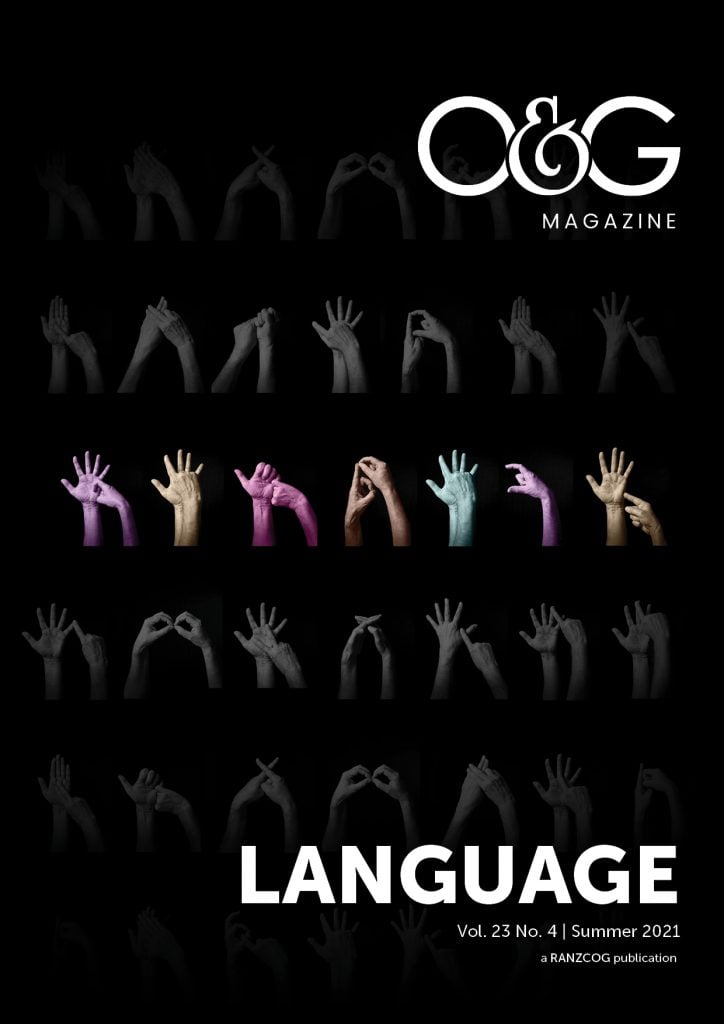Language is a powerful tool. It can be used to educate and empower. It can be used to disempower and silence. The language used to describe women with pelvic pain has a dark history steeped in stigma and silence. The stories I hear at our support group tell me we have a long way to go before women are seen, believed and heard.
‘For most of history there has been a widely held notion that women are irrational and brimming with uncontrollable emotions and bodily functions.’1 From the beginning of medicine, the womb was blamed for almost any illness that occurred to women, many of them were labelled as having their origin in hysteria. The word hysteria comes from the Latin word hystericus (of the womb). The condition of hysteria was thought to be exclusive to women that would send them uncontrollably and neurotically insane due to a dysfunction in the uterus. The cure was often brutal surgery to remove the uterus (which is still called a hysterectomy today).2 Dr Kate Young, a researcher, found that even today when women persist with their doctors after all available tools have been exhausted, the hysterical narrative begins to re-emerge.2
Some women also know shockingly little about their anatomy. They are not equipped with the language to describe their bodies or the processes that they undergo. This makes it very difficult to accurately describe symptoms and pain to a doctor. In our culture, we don’t use the correct words for female anatomy, and female anatomy is often used as derogatory slang.3
Dr Young sums up the dilemma of women’s sexuality today, ‘medical texts have historically constructed women’s sexuality as volatile and in need to control; uncontrolled, it would lure men from their intellectual pursuits and distract women from their assigned reproductive role, it is necessary for them to engage in (penis-vaginal) sex with men. Thus, women are expected to endure but not enjoy sex, and the physical ability to do so became medically pathologized whilst little to no consideration was given to their sexual pleasure.’4
Labelling all women with persistent pain as hysterical and blaming their uterus has been the perfect recipe to silence women. Furthermore, not teaching women about their bodies has been another powerful weapon to disempower women. It is very difficult to raise an issue when you don’t have the language to describe the problem, and know that you’ll probably be labelled hysterical if you do. As a society we still have the prevailing attitude that painful periods are part of being a woman, and painful sex should be endured.
I know the power of language and being silenced firsthand. I experienced a 17-year diagnosis delay. I still live with the impact of 17 years of being told there was nothing wrong with me, that I was making the pain up. Even now, if I ever need to go to hospital, the words that I heard behind hospital curtains across those 17 years bounce around my head with the same clarity as the days that I heard them. I now have confirmation that I wasn’t crazy and it wasn’t all in my head, but language is powerful. I believed for a long time that there was something fundamentally and psychiatrically wrong with me.
A few years ago, when I went into early labour, I drove myself into my scheduled doctor’s appointment. My stomach was huge physical evidence of why I had pain. I was at the end of my pregnancy. But those words came back to haunt me. I was in an internal wrestle all afternoon about whether my labour pains were real or not. I know from my training that what I was experiencing is medical trauma. When I made it to my doctor and they asked why I didn’t call, I just stared and blinked. Still in the freeze state unable to speak my truth about the fear that I wasn’t actually in labour and maybe I was just making it all up.
Soon after that, something was born in me too. An itching or inkling that I had to find my voice so that others would not be silenced. I had researched a lot over the 17 years that I didn’t have a diagnosis. I didn’t have the right words to find what I was looking for. I didn’t have the language to ask for help, and for many years I gave up asking and searching because I was resigned to the fact that whatever was wrong with me was somehow my fault.
I started to read everything I could about endometriosis, pelvic pain and chronic pain. I wanted to understand if you could live well with pelvic pain, and why my story was so common. I am forever grateful for books like Endometriosis and Pelvic Pain5 and Pain and Prejudice6 which not only gave me the language to describe my experience but gave me the support that I needed. Those books helped me feel seen and believed.
The first time I spoke publicly about my experience with endometriosis was unexpectedly confronting. I hadn’t thought about the fact that I had never really talked openly about my experience. I hadn’t really thought about how strongly that belief that maybe I was crazy remained. Until that day, I had lived by denying and underplaying my story. As Brené Brown says ‘Owning our story and loving ourselves through that process is the bravest thing we’ll ever do.’7 Standing up and owning my story was one of the hardest things I have done. Owning the fear and the trauma and not minimising it empowered me and the women in the room who heard it.
I now run a support group for people with endometriosis, adenomyosis, PCOS and any other type of pelvic pain. A key component of the group is to provide a safe space for women to find the language and their voice to describe what has happened to them. We have professionals come and talk so that women can ask questions in a safe environment. No topic is off limits, and all attendees are encouraged to be open and share their experience.
I now tell my story and stories of others on an almost weekly basis. I have the language to describe the lived experience of women with pelvic pain, and the research statistics to back up their stories. I have no qualms about talking about menstruation, or painful sex. It took practice but it is now part of my everyday vocabulary. I use this combination when speaking with journalists, ‘Endo Warriors’ and politicians.
I am passionate about changing this space. I will work in this space for as long as I can and have conversations about women’s pain and sexuality. It amazes me that 800,000 people in Australia alone have endometriosis, making it as common as asthma and diabetes, and yet it has received so little recognition and funding to date. How do we unite these women? How do we empower them to rise up as a collective and use their voices to say, this isn’t good enough? I can’t see any negatives to empowering women to understand more about their bodies and to be able to get help before their pain becomes disabling and chronic.
I live with the scars of how much language can hurt, and how powerful it can be in silencing and shaming a person. I would argue that every woman lives with the hurt and coercive control that language has had over our bodies and reproductive health. I have also seen how powerful language can be in empowering and uplifting people to live their best lives. Language is a powerful tool that can literally change a person’s life.
I encourage you to think about how you use language to talk to those with pelvic pain, to describe those with pelvic pain, and to describe the pain itself. Check your own bias and language, and think about how you can empower those with pelvic pain to live well and find their voice.
Three of the most powerful words you can use to start any conversation with someone with pelvic pain are: I believe you.
Kat Stanley is the Director of the Endo Help Foundation, and facilitator of the Endo Help support group
Related article
Understanding the language of pelvic pain
Our feature articles represent the views of our authors and do not necessarily represent the views of the Royal Australian and New Zealand College of Obstetricians and Gynaecologists (RANZCOG), who publish O&G Magazine. While we make every effort to ensure that the information we share is accurate, we welcome any comments, suggestions or correction of errors in our comments section below, or by emailing the editor at [email protected].
References
- Jackson, G. Pain and Prejudice. Allen & Unwin, 2019. 1-158
- Jackson, G. Pain and Prejudice. Allen & Unwin, 2019. 1-158
- Jackson, G. Pain and Prejudice. Allen & Unwin, 2019. 1-158
- Young K, Fisher J, Kirkman M. Clinicians’ perceptions of women’s experiences of endometriosis and of psychosocial care for endometriosis. ANZJOG. 2017. DOI 10.1111/ajo.12571.
- Evans Susan. Endometriosis and Pelvic pain. Little, Brown Book Group. 2016.
- Jackson, G. Pain and Prejudice. Allen & Unwin, 2019. 1-158
- Brown B. Rising Strong: How the Ability to Reset Transforms the Way We Live, Love, Parent. Spiegel & Grau, 2015.






Leave a Reply